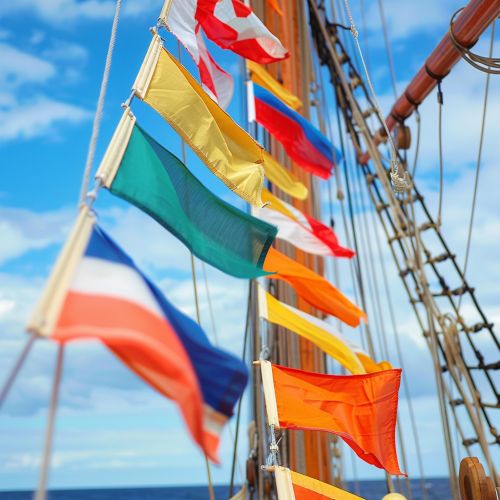International Code of Signals
Introduction
The International Code of Signals (ICS) is a system of signals and codes used by vessels to communicate important messages regarding safety and navigation. The ICS is designed to be understood by all mariners, regardless of the language they speak, and it is used internationally to ensure clear and effective communication at sea. The code includes a variety of signals, such as flags, lights, and sounds, which can convey complex messages quickly and efficiently.
History
The origins of the International Code of Signals can be traced back to the early 19th century when maritime communication was becoming increasingly important due to the growth of international trade. The first standardized system of maritime signals was introduced by the British Board of Trade in 1855. This system was later revised and expanded to include more signals and to be more universally applicable.
In 1931, the International Radiotelegraph Conference in Madrid adopted a revised version of the code, which included radiotelegraphy signals. The most significant update to the ICS came in 1965 when the International Maritime Organization (IMO) adopted a new version of the code, which is still in use today. This version was designed to be more comprehensive and to include signals for a wider range of situations.
Structure of the Code
The International Code of Signals is divided into several sections, each of which covers a different aspect of maritime communication. The main sections of the code include:
Signal Flags
Signal flags are one of the most recognizable components of the ICS. Each flag represents a different letter of the alphabet, and combinations of flags can be used to spell out messages. There are also special flags that represent specific messages or instructions. For example, the Bravo flag (a red flag with a white square in the center) indicates that a vessel is carrying dangerous cargo.


Morse Code
Morse code is another important component of the ICS. It is used to communicate messages using a series of dots and dashes, which can be transmitted via light or sound. Morse code is particularly useful for long-distance communication, as it can be transmitted using a variety of methods, including radio, signal lamps, and whistles.
Radiotelephony
Radiotelephony involves the use of voice communication over radio waves. The ICS includes a standardized set of phrases and procedures for radiotelephony communication, which are designed to ensure clarity and prevent misunderstandings. For example, the phrase "Mayday" is used to indicate a distress situation, while "Pan-Pan" indicates an urgent but non-life-threatening situation.
Sound Signals
Sound signals are used to communicate messages in situations where visual signals may not be effective, such as in fog or heavy rain. The ICS includes a variety of sound signals, such as blasts from a ship's horn or whistle, which can convey different messages. For example, one short blast indicates that a vessel is altering its course to starboard, while two short blasts indicate a course alteration to port.
Usage and Application
The International Code of Signals is used by vessels of all types and sizes, from small pleasure craft to large commercial ships. It is particularly important for vessels operating in international waters, where language barriers can make communication difficult. The ICS is also used by shore-based facilities, such as ports and harbors, to communicate with vessels.
Emergency Situations
One of the most critical applications of the ICS is in emergency situations. The code includes a variety of signals for distress and emergency communication, which can be used to request assistance or to indicate a hazardous situation. For example, the SOS signal (three short, three long, three short) is universally recognized as a call for help.
The ICS is also used to communicate navigational information and to coordinate maneuvers between vessels. This can include signals for indicating a vessel's intended course, requesting permission to enter a port, or warning other vessels of potential hazards. For example, the Alpha flag (a white and blue flag) is used to indicate that a vessel has a diver down and that other vessels should keep clear.
Training and Certification
Proper use of the International Code of Signals requires training and certification. Mariners are typically trained in the use of the ICS as part of their basic maritime education, and they may be required to demonstrate proficiency in the code as part of their certification process. This training ensures that all mariners are capable of using the ICS effectively and that they understand the importance of clear communication at sea.
Technological Advances
While the basic principles of the International Code of Signals have remained largely unchanged, technological advances have led to new methods of communication that complement the traditional signals. For example, the use of AIS allows vessels to transmit their position and other information electronically, which can enhance situational awareness and improve safety.
Conclusion
The International Code of Signals is an essential tool for maritime communication, providing a standardized system for conveying important messages regarding safety and navigation. Its comprehensive and versatile nature ensures that it remains relevant in the modern maritime industry, and its continued use is a testament to its effectiveness in promoting clear and efficient communication at sea.
